
Lyme Park is a large estate south of Disley, Cheshire, England, managed by the National Trust and consisting of a mansion house surrounded by formal gardens and a deer park in the Peak District National Park. The house is the largest in Cheshire, and is recorded in the National Heritage List for England as a designated Grade I listed building.

Studley Royal Park including the ruins of Fountains Abbey is a designated World Heritage Site in North Yorkshire, England. The site, which has an area of 323 hectares features an 18th-century landscaped garden, some of the largest Cistercian ruins in Europe, ruins of a Jacobean mansion and a Victorian church designed by William Burges. It was developed around the house, destroyed in a fire in 1946, and eventually came to include the ruins of the Cistercian Fountains Abbey.

Castlecaulfield is a village in County Tyrone, Northern Ireland. It lies about 2 miles west of Dungannon and is part of the Mid Ulster District Council area. The village is mostly within the townland of Drumreany, although part of it extends into Lisnamonaghan. It is situated in the historic Barony of Dungannon Middle and the civil parish of Donaghmore. It has been called "Caufle" by local people for upwards of two hundred years as evidenced by a sketch of the Castle c1830 in which the artist refers to 'Castle Coffell'.
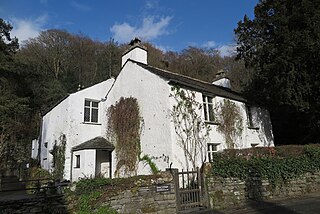
Dove Cottage is a house on the edge of Grasmere in the Lake District of England. It is best known as the home of the poet William Wordsworth and his sister Dorothy Wordsworth from December 1799 to May 1808, where they spent over eight years of "plain living, but high thinking". During this period, William wrote much of the poetry for which he is remembered today, including his "Ode: Intimations of Immortality", "Ode to Duty", "My Heart Leaps Up" and "I Wandered Lonely as a Cloud", together with parts of his autobiographical epic, The Prelude.
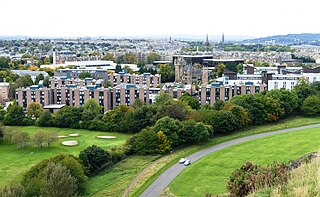
Pollock Halls of Residence is the largest halls of residence for the University of Edinburgh, located at the foot of Arthur's Seat in Edinburgh, Scotland. The complex of buildings houses more than 2,000 undergraduate students during term time, and is available to the public as bed and breakfast-style accommodation outside of the teaching term. While some of the buildings date from the 19th century, the majority of Pollock Halls dates from the 1960s and early 2000s. Pollock Halls are located on the edge of Holyrood Park, 1+1⁄4 miles (2.0 km) southeast of the centre of Edinburgh, and 3⁄4 mile (1.2 km) from the university's central area around George Square.

Appleby Castle is in the town of Appleby-in-Westmorland overlooking the River Eden. It consists of a 12th-century castle keep which is known as Caesar's Tower, and a mansion house. These, together with their associated buildings, are set in a courtyard surrounded by curtain walls. Caesar's Tower and the mansion house are each recorded in the National Heritage List for England as a designated Grade I listed building. The uninhabited parts of the castle are a scheduled ancient monument.
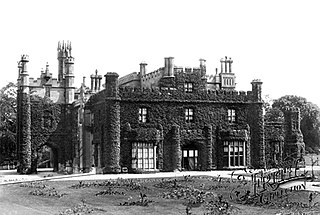
Rood Ashton House was a country house in Wiltshire, England, standing in parkland 0.5 miles (0.80 km) northeast of the village of West Ashton, near Trowbridge. Built in 1808 for Richard Godolphin Long, it was later the home of the 1st Viscount Long (1854–1924).

Churche's Mansion is a timber-framed, black-and-white Elizabethan mansion house at the eastern end of Hospital Street in Nantwich, Cheshire, England. The Grade I listed building dates from 1577, and is one of the very few to have survived the Great Fire of Nantwich in 1583.
Knypersley Hall is an 18th-century Georgian style country mansion at Biddulph, Staffordshire, England. It is protected as a Grade II* Listed building. After falling into a state of disrepair it was partially subdivided into residential apartments, although the Hall was not wholly restored at this point and was falling into further disrepair. However, the current owner has restored, repaired and divided into three separate residential dwellings - Knypersley Hall, East View and West View which complement the remainder of the original buildings which were part of the original Hall Estate.

Minsteracres is an 18th-century mansion house, now a Christian retreat centre, in Northumberland, England. It is a Grade II listed building.

Horham Hall may refer to the timber-framed late mediaeval hall in Thaxted, England or to the brick hall built in its place by Sir John Cutte in the early 16th century.
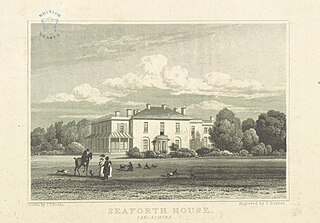
Seaforth House was a mansion in Seaforth, Merseyside England built in 1813 for Sir John Gladstone, father of William Ewart Gladstone who was Prime Minister of the United Kingdom four times.

Whitley Hall is a 16th-century mansion which since 1969 has been converted into a restaurant and then a hotel. It is situated in the northern rural district of the City of Sheffield in South Yorkshire, England. The small hamlet of Whitley lies in the countryside between the suburbs of Grenoside, Chapeltown and Ecclesfield some 7.5 km (4.7 mi) north of the city centre. The hall is a Grade II* listed building.
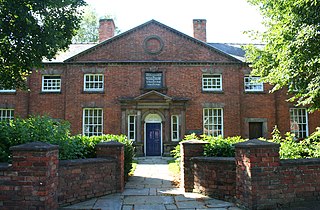
Crewe Almshouses or Crewe's Almshouses is a terrace of seven former almshouses at the end of Beam Street in Nantwich, Cheshire, England. The present building was erected in 1767 by John Crewe, later first Baron Crewe, and is listed at grade II. It has a central projecting section topped by a pediment, with a stone doorway flanked with Tuscan columns. The present almshouses stand on the site of a 16th-century building, originally the mansion of the Mainwaring family and later the town's House of Correction and workhouse.

The Wilbraham's Almshouses, also known as the Wilbraham Almshouses, are six former almshouses in Nantwich, Cheshire, England, located on the north side of Welsh Row at numbers 112–116. Founded by Sir Roger Wilbraham in 1613, they were the town's earliest almshouses. They remained in use as almshouses until 1870, when they were replaced by the adjacent Tollemache Almshouses. The timber-framed building, which is listed at grade II, was subsequently used as a malthouse and as cottages, and was later considerably altered to form a single house. The Hospital of St Lawrence, a medieval house for lepers, might have been situated nearby.

Barrow House is a late 18th-century mansion situated on the eastern shore of Derwentwater in Borrowdale within the Lake District National Park, in the county of Cumbria, England. The house is a Grade II listed building which since the time of its construction has had various uses, it was originally a private dwelling and has since served as a hotel, a youth hostel run by the YHA and is now an independent hostel.

Riverdale House is a Victorian mansion located at 89 Graham Road in the Ranmoor area of Sheffield, England. Formerly a private residence, the building, which is Grade II Listed has now been adopted for commercial use and accommodates several small businesses.
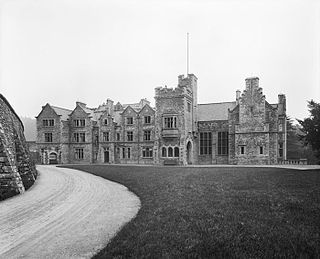
Grizedale Hall was a large country house at Grizedale, Hawkshead, in the Lake District in Cumbria, England. After two earlier Grizedale Halls had preceded, it was built anew in 1905 in the style of Gothic Revival architecture. During World War II it became No 1 Prisoner-of-war camp to hold German officers and was finally pulled down in 1957.

Mallow Castle is a National Monument situated off the N72 on Bridewell Lane, Mallow, County Cork, Ireland.
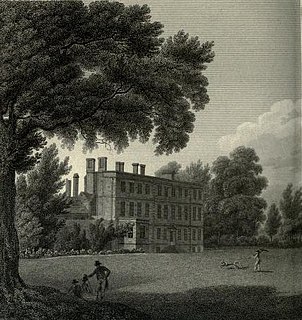
Twickenham Meadows, later known as Cambridge Park, was a 74-acre estate, the second largest estate in Twickenham, England, after Twickenham Park. It has now been built over and the name remains for a part of Twickenham in optional – station-centric terms – considered St Margarets. The estate included a three-storey brick Jacobean mansion which was built around 1610 and was later known as Cambridge House. The house was demolished in 1937




















